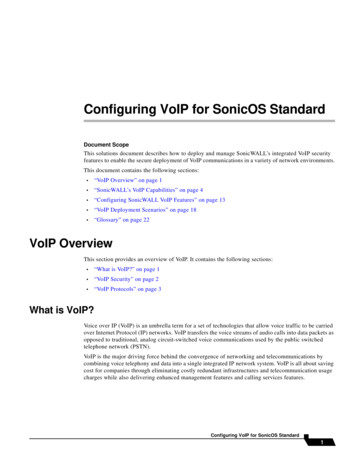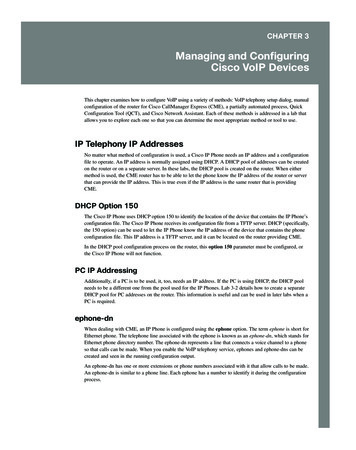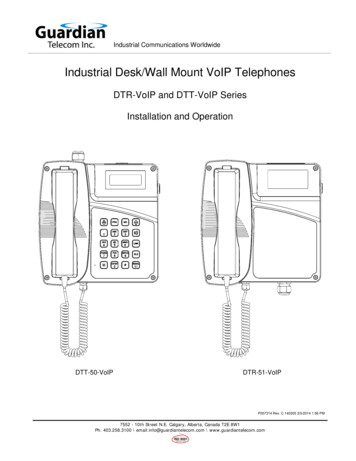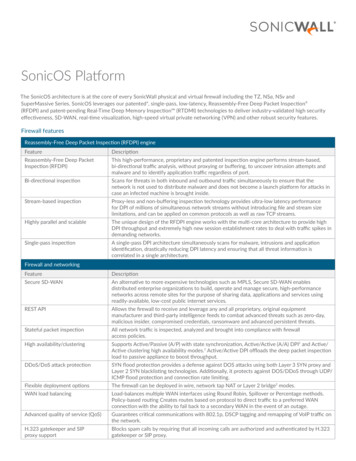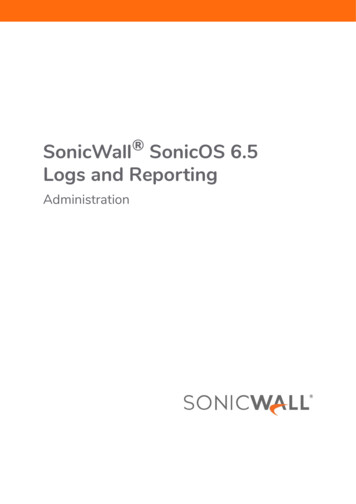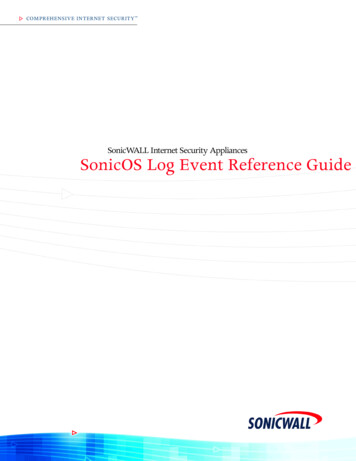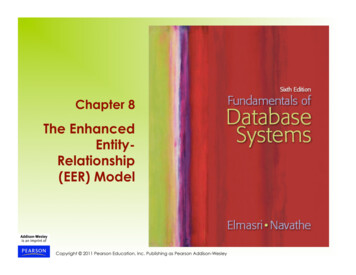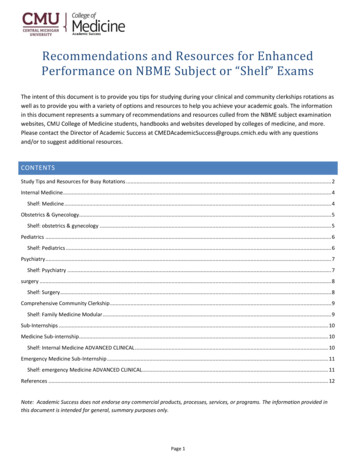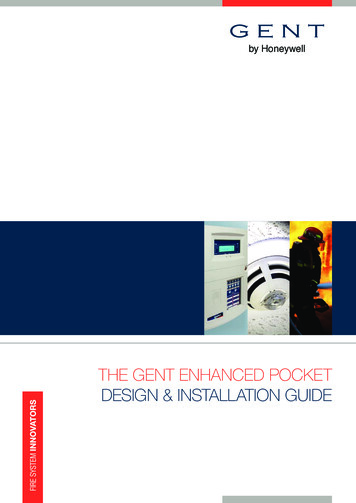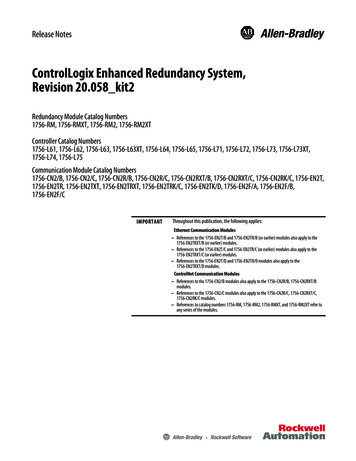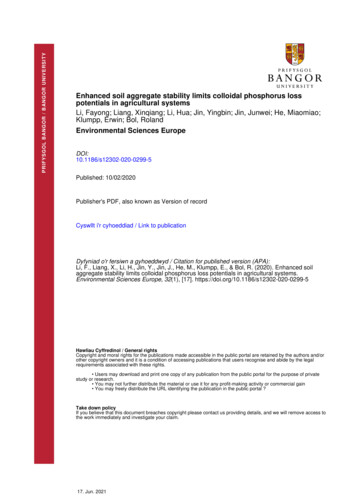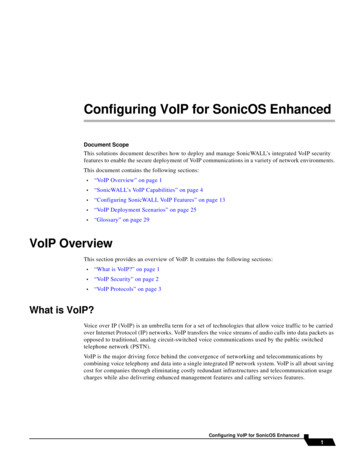
Transcription
Configuring VoIP for SonicOS EnhancedDocument ScopeThis solutions document describes how to deploy and manage SonicWALL’s integrated VoIP securityfeatures to enable the secure deployment of VoIP communications in a variety of network environments.This document contains the following sections: “VoIP Overview” on page 1 “SonicWALL’s VoIP Capabilities” on page 4 “Configuring SonicWALL VoIP Features” on page 13 “VoIP Deployment Scenarios” on page 25 “Glossary” on page 29VoIP OverviewThis section provides an overview of VoIP. It contains the following sections: “What is VoIP?” on page 1 “VoIP Security” on page 2 “VoIP Protocols” on page 3What is VoIP?Voice over IP (VoIP) is an umbrella term for a set of technologies that allow voice traffic to be carriedover Internet Protocol (IP) networks. VoIP transfers the voice streams of audio calls into data packets asopposed to traditional, analog circuit-switched voice communications used by the public switchedtelephone network (PSTN).VoIP is the major driving force behind the convergence of networking and telecommunications bycombining voice telephony and data into a single integrated IP network system. VoIP is all about savingcost for companies through eliminating costly redundant infrastructures and telecommunication usagecharges while also delivering enhanced management features and calling services features.Configuring VoIP for SonicOS Enhanced1
VoIP OverviewVoIP SecurityCompanies implementing VoIP technologies in an effort to cut communication costs and extendcorporate voice services to a distributed workforce face security risks associated with the convergenceof voice and data networks. VoIP security and network integrity are an essential part of any VoIPdeployment.The same security threats that plague data networks today are inherited by VoIP but the addition of VoIPas an application on the network makes those threats even more dangerous. By adding VoIP componentsto your network, you’re also adding new security requirements.VoIP encompasses a number of complex standards that leave the door open for bugs and vulnerabilitieswithin the software implementation. The same types of bugs and vulnerabilities that hamper everyoperating system and application available today also apply to VoIP equipment. Many of today's VoIPcall servers and gateway devices are built on vulnerable Windows and Linux operating systems.Firewall Requirements for VoIPVoIP is more complicated than standard TCP/UDP-based applications. Because of the complexities ofVoIP signaling and protocols, as well as inconsistencies that are introduced when a firewall modifiessource address and source port information with Network Address Translation (NAT), it is difficult forVoIP to effectively traverse a standard firewall. Here are a few of the reasons why. VoIP operates using two separate protocols - A signaling protocol (between the client and VoIPServer) and a media protocol (between the clients). Port/IP address pairs used by the mediaprotocols (RTP/RTCP) for each session are negotiated dynamically by the signaling protocols.Firewalls need to dynamically track and maintain this information, securely opening selected portsfor the sessions and closing them at the appropriate time. Multiple media ports are dynamically negotiated through the signaling session - negotiationsof the media ports are contained in the payload of the signaling protocols (IP address and portinformation). Firewalls need to perform deep packet inspection on each packet to acquire theinformation and dynamically maintain the sessions, thus demanding extra firewall processing. Source and destination IP addresses are embedded within the VoIP signaling packets - Afirewall supporting NAT translates IP addresses and ports at the IP header level for packets. Fullysymmetric NAT firewalls adjust their NAT bindings frequently, and may arbitrarily close thepinholes that allow inbound packets to pass into the network they protect, eliminating the serviceprovider's ability to send inbound calls to the customer. To effectively support VoIP it is necessaryfor a NAT firewall to perform deep packet inspection and transformation of embedded IP addressesand port information as the packets traverse the firewall. Firewalls need to process the signaling protocol suites consisting of different message formatsused by different VoIP systems - Just because two vendors use the same protocol suite does notnecessarily mean they will interoperate.To overcome many of the hurdles introduced by the complexities of VoIP and NAT, vendors are offeringSession Border Controllers (SBCs). An SBC sits on the Internet side of a firewall and attempts to controlthe border of a VoIP network by terminating and re-originating all VoIP media and signalling traffic. Inessence, SBCs act as a proxy for VoIP traffic for non-VoIP enabled firewalls. SonicWALL securityappliances are VoIP enabled firewalls that eliminate the need for an SBC on your network.Configuring VoIP for SonicOS Enhanced2
VoIP OverviewVoIP ProtocolsVoIP technologies are built on two primary protocols, H.323 and SIP.H.323H.323 is a standard developed by the International Telecommunications Union (ITU). It’s acomprehensive suite of protocols for voice, video, and data communications between computers,terminals, network devices, and network services. H.323 is designed to enable users to makepoint-to-point multimedia phone calls over connectionless packet-switching networks such as private IPnetworks and the Internet. H.323 is widely supported by manufacturers of video conferencingequipment, VoIP equipment and Internet telephony software and devices.H.323 uses a combination of TCP and UDP for signaling and ASN.1 for message encoding. H.323v1was released in 1996 and H.323v5 was released in 2003. As the older standard, H.323 was embraced bymany early VoIP players.An H.323 network consists of four different types of entities: Terminals - Client end points for multimedia communications. An example would be an H.323enabled Internet phone or PC. Gatekeepers - Performs services for call setup and tear down, and registering H.323 terminals forcommunications. Includes:– Address translation.– Registration, admission control, and status (RAS).– Internet Locator Service (ILS) also falls into this category (although it is not part of H.323). ILSuses LDAP (Lightweight Directory Access Protocol) rather than H.323 messages. Multipoint control units (MCUs) - Conference control and data distribution for multipointcommunications between terminals. Gateways - Interoperation between H.323 networks and other communications services, such as thecircuit-switched Packet Switched Telephone Network (PSTN).SIPThe Session Initiation Protocol (SIP) standard was developed by the Internet Engineering Task Force(IETF). RFC 2543 was released in March 1999. RFC 3261 was released in June 2002. SIP is a signalingprotocol for initiating, managing and terminating sessions. SIP supports ‘presence’ and mobility and canrun over User Datagram Protocol (UDP) and Transmission Control Protocol (TCP).Using SIP, a VoIP client can initiate and terminate call sessions, invite members into a conferencingsession, and perform other telephony tasks. SIP also enables Private Branch Exchanges (PBXs), VoIPgateways, and other communications devices to communicate in standardized collaboration. SIP wasalso designed to avoid the heavy overhead of H.323.A SIP network is composed of the following logical entities: User Agent (UA) - Initiates, receives and terminates calls. Proxy Server - Acts on behalf of UA in forwarding or responding to requests. A Proxy Server canfork requests to multiple servers. A back-to-back user agent (B2BUA) is a type of Proxy Server thattreats each leg of a call passing through it as two distinct SIP call sessions: one between it and thecalling phone and the other between it and the called phone. Other Proxy Servers treat all legs of thesame call as a single SIP call session.Configuring VoIP for SonicOS Enhanced3
SonicWALL’s VoIP Capabilities Redirect Server - Responds to request but does not forward requests. Registration Server - Handles UA authentication and registration.SonicWALL’s VoIP CapabilitiesThe following sections describe SonicWALL’s integrated VoIP service: “VoIP Security” on page 4 “VoIP Network” on page 5 “VoIP Network Interoperability” on page 5 “Supported VoIP Protocols” on page 7VoIP Security Application-layer protection for VoIP protocols - Full protection from application-level VoIPexploits through SonicWALL Intrusion Prevention Service (IPS). IPS integrates a configurable,high performance scanning engine with a dynamically updated and provisioned database of attackand vulnerability signatures to protect networks against sophisticated Trojans and polymorphicthreats. SonicWALL extends its IPS signature database with a family of VoIP-specific signaturesdesigned to prevent malicious traffic from reaching protected VoIP phones and servers. Signaturegranularity allows SonicWALL IPS to detect and prevent attacks based on a global, attack group, orper-signature basis to provide maximum flexibility and control false positives. DoS and DDoS attack protection - Prevention of DoS and DDoS attacks, such as the SYN Flood,Ping of Death, and LAND (IP) attack, which are designed to disable a network or service.– Validating packet sequence for VoIP signaling packets using TCP to disallow out of sequenceand retransmitted packets beyond window.– Using randomized TCP sequence numbers (generated by a cryptographic random numbergenerator during connection setup) and validating the flow of data within each TCP session toprevent replay and data insertion attacks.– Ensures that attackers cannot overwhelm a server by attempting to open many TCP/IPconnections (which are never fully established-usually due to a spoofed source address) byusing SYN Flood protection. Encrypted VoIP Device Support - SonicWALL supports VoIP devices capable of using encryptionto protect the media exchange within a VoIP conversation or secure VoIP devices that do not supportencrypted media using IPSec VPNs to protect VoIP calls. Stateful monitoring - Stateful monitoring ensures that packets, even though appearing valid inthemselves, are appropriate for the current state of their associated VoIP connection. Traffic legitimacy - Stateful inspection of every VoIP signaling and media packet traversing thefirewall ensures all traffic is legitimate. Packets that exploit implementation flaws, causing effectssuch as buffer overflows in the target device, are the weapons of choice for many attackers.SonicWALL security appliances detect and discard malformed and invalid packets before they reachtheir intended target.Configuring VoIP for SonicOS Enhanced4
SonicWALL’s VoIP CapabilitiesVoIP NetworkNoteSonicWALL’s Secure Wireless Solution includes the network enablers to extend secure VoIPcommunications over wireless networks. Refer to the SonicWALL Secure Wireless NetworkIntegrated Solutions Guide available on the SonicWALL documentation sitehttp://www.sonicwall.com/support /documentation.html for complete information. Bandwidth Management (BWM) and Quality-of-Service (QoS) - Bandwidth management (bothingress and egress) can be used to ensure that bandwidth remains available for time-sensitive VoIPtraffic. BWM is integrated into SonicWALL Quality of Service (QoS) features (on SonicOSEnhanced) to provide predictability that is vital for certain types of applications. High availability - High availability is provided by SonicOS hardware failover, which ensuresreliable, continuous connectivity in the event of a system failure. VoIP over Wireless LAN (WLAN) - SonicWALL extends complete VoIP security to attachedwireless networks with its Distributed Wireless Solution. All of the security features provided toVoIP devices attached to a wired network behind a SonicWALL are also provided to VoIP devicesusing a wireless network. WAN redundancy and load balancing - WAN redundancy and load balancing allows for aninterface to act as a secondary or backup WAN port. The secondary WAN port can also be used ina more dynamic load balancing, active/active setup, where outbound traffic flows are dividedbetween the primary and secondary WAN ports for increased throughput.VoIP Network Interoperability Comprehensive monitoring and reporting - For all supported VoIP protocols, SonicOS offersextensive monitoring and troubleshooting tools:– Dynamic live reporting of active VoIP calls, indicating the caller and called parties, andbandwidth used.– Audit logs of all VoIP calls, indicating caller and called parties, call duration, and totalbandwidth used. Logging of abnormal packets seen (such as a bad response) with details of theparties involved and condition seen.– Detailed syslog reports and ViewPoint reports for VoIP signaling and media streams.SonicWALL ViewPoint is a Web-based graphical reporting tool that provides detailed andcomprehensive reports of your security and network activities based on syslog data streamsreceived from the firewall. Reports can be generated about virtually any aspect of firewallactivity, including individual user or group usage patterns and events on specific firewalls orgroups of firewalls, types and times of attacks, resource consumption and constraints, etc. Configurable inactivity timeouts for signaling and media - In order to ensure that dropped VoIPconnections do not stay open indefinitely, SonicOS monitors the usage of signaling and mediastreams associated with a VoIP session. Streams that are idle for more than the configured timeoutare shut down to prevent potential security holes. Full syntax validation of all VoIP signaling packets - Received signaling packets are fully parsedwithin SonicOS to ensure they comply with the syntax defined within their associated standard. Byperforming syntax validation, the firewall can ensure that malformed packets are not permitted topass through and adversely affect their intended target.Configuring VoIP for SonicOS Enhanced5
SonicWALL’s VoIP Capabilities Plug-and-protect support for VoIP devices - With SonicOS, VoIP device adds, changes, andremovals are handled automatically, ensuring that no VoIP device is left unprotected. Usingadvanced monitoring and tracking technology, a VoIP device is automatically protected as soon asit is plugged into the network behind a SonicWALL security appliance. SonicOS allows the administrator to control incoming calls - By requiring that all incoming callsare authorized and authenticated by the H.323 Gatekeeper or SIP Proxy, SonicOS can blockunauthorized and spam calls. This allows the administrator to be sure that the VoIP network is beingused only for those calls authorized by the company. Support for dynamic setup and tracking of media streams - SonicOS tracks each VoIP call fromthe first signaling packet requesting a call setup, to the point where the call ends. Only based on thesuccessful call progress are additional ports opened (for additional signaling and media exchange)between the calling and called party.Media ports that are negotiated as part of the call setup are dynamically assigned by the firewall.Subsequent calls, even between the same parties, will use different ports, thwarting an attacker whomay be monitoring specific ports. Required media ports are only opened when the call is fullyconnected, and are shut down upon call termination. Traffic that tries to use the ports outside of thecall is dropped, providing added protection to the VoIP devices behind the firewall. Validation of headers for all media packets - SonicOS examines and monitors the headers withinmedia packets to allow detection and discarding of out-of-sequence and retransmitted packets(beyond window). Also, by ensuring that a valid header exists, invalid media packets are detectedand discarded. By tracking the media streams as well as the signaling, SonicWALL providesprotection for the entire VoIP session.Configuring VoIP for SonicOS Enhanced6
SonicWALL’s VoIP CapabilitiesSupported VoIP ProtocolsSonicWALL security appliances support transformations for the following protocols.H.323SonicOS provides the following support for H.323: VoIP devices running all versions of H.323 (currently 1 through to 5) are supported Microsoft's LDAP-based Internet Locator Service (ILS) Discovery of the Gatekeeper by LAN H.323 terminals using multicast Stateful monitoring and processing of Gatekeeper registration, admission, and status (RAS)messages Support for H.323 terminals that use encryption for the media streams DHCP Option 150. The SonicWALL DHCP Server can be configured to return the address of a VoIPspecific TFTP server to DHCP clients In addition to H.323 support, SonicOS supports VoIP devices using the following additional ITUstandards:– T.120 for application sharing, electronic white-boarding, file exchange, and chat– H.239 to allow multiple channels for delivering audio, video and data– H.281 for Far End Camera Control (FECC)SIPSonicOS provides the following support for SIP:– Base SIP standard (both RFC 2543 and RFC 3261)– SIP INFO method (RFC 2976)– Reliability of provisional responses in SIP (RFC 3262)– SIP specific event notification (RFC 3265)– SIP UPDATE method (RFC 3311)– DHCP option for SIP servers (RFC 3361)– SIP extension for instant messaging (RFC 3428)– SIP REFER method (RFC 3515)– Extension to SIP for symmetric response routing (RFC 3581)Configuring VoIP for SonicOS Enhanced7
SonicWALL’s VoIP CapabilitiesSonicWALL VoIP Vendor InteroperabilityThe following is a partial list of devices from leading manufacturers with which SonicWALL VoIPinteroperates.H.323Soft-phones:Microsoft NetMeetingOpenPhoneSJLabs SJ PhoneTelephones/VideoPhones:Cisco 7905D-Link DV 1000PolyCom VS-FXSony PCS-1Sony PCS-11Gatekeepers:Cisco IOSOpenH323 GatekeeperGateway:Cisco VG200SIPSoft-phones:Apple iChat MicrosoftMSN MessengerNortel Multimedia PC ClientPingTel Instant XpressaSiemens SCS Client SJLabsSJPhoneXTen X-LiteUbiquity SIP User AgentTelephones/ATAs:Cisco 7905Cisco 7960Cisco ATA 186Grandstream BudgetOne 100Mitel 5055Packet8 ATAPingTel Xpressa PolyComSoundPoint IP 500Pulver Innovations WiSIPSIP Proxies/Services:Cisco SIP Proxy ServerBrekeke Software OnDo SIP ProxyPacket8Siemens SCS SIP ProxyVonageConfiguring VoIP for SonicOS Enhanced8
SonicWALL’s VoIP CapabilitiesCODECsSonicOS supports media streams from any CODEC - Media streams carry audio and video signalsthat have been processed by a hardware/software CODEC (COder/DECoder) within the VoIP device.CODECs use coding and compression techniques to reduce the amount of data required to representaudio/video signals. Some examples of CODECs are: H.264, H.263, and H.261 for video MPEG4, G.711, G.722, G.723, G.728, G.729 for audioVoIP Protocols that SonicOS Does Not Perform Deep Packet Inspection onSonicWALL security appliances running SonicOS Enhanced do not currently support deep packetinspection for the following protocols; therefore, these protocols should only be used in non-NATenvironments. Proprietary extensions to H.323 or SIP MGCP Megaco/H.248 Cisco Skinny Client Control Protocol (SCCP) IP-QSIG Proprietary protocols (Mitel’s MiNET, 3Com NBX, etc.)Configuring VoIP for SonicOS Enhanced9
SonicWALL’s VoIP CapabilitiesHow SonicOS Handles VoIP CallsSonicOS provides an efficient and secure solution for all VoIP call scenarios. The following areexamples of how SonicOS handles VoIP call flows.Incoming CallsFigure 1 shows the sequence of events that occur during an incoming VoIP call.Figure 1Incoming VoIP Call FlowThe following describes the sequence of events shown in Figure 1.1.Phone B registers with VoIP server - The SonicWALL security appliance builds a database of theaccessible IP phones behind it by monitoring the outgoing VoIP registration requests. SonicOStranslates between phone B’s private IP address and the firewall’s public IP address used inregistration messages. The
VoIP devices attached to a wired network behind a SonicWALL are also provided to VoIP devices using a wireless network. WAN redundancy and load balancing - WAN redundancy and load balancing allows for an interface to act as a secondary or backup WAN
